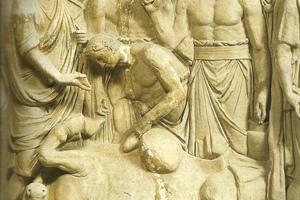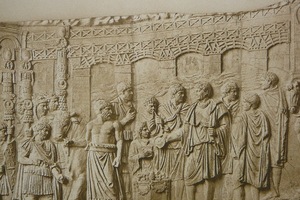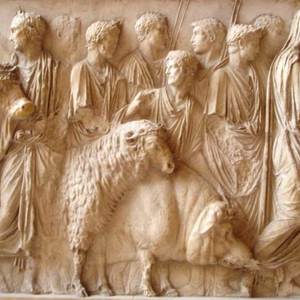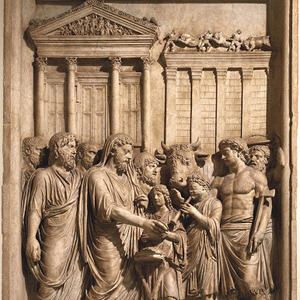Attention! This section of the site may contain materials intended for persons over 18 years of age.
Are you over 18 years old?
Sacrifices in Ancient Rome
Варнаков М.С.
All Roman sacrifices can be divided into two categories. The first category includes public sacrifices (sacra publica), performed by state priests in honor of important state celebrations. The second category consists of private sacrifices (sacra privata), which were conducted in honor of household gods.
Public offerings
Public sacrifices typically followed a set procedure. A person participating in a public sacrifice needed to bathe in running water. If this was not possible, they had to sprinkle themselves with water from a sprinkler. They would then dress in festive clothing (white) and adorn their head with a wreath. The sacrifice would begin with the phrase "favete linguis," calling for silence, as it was believed that loud conversations could disrupt the sacrifice.
Next, the priest would offer a prayer (precatio) before the image of the god, standing with raised hands, his head covered by a toga to prevent distractions. Sometimes prayers were offered on bended knee, with hands touching the sacrificial altar.
Following the prayer, the main part of the sacrifice commenced. Male animals were offered to gods, and female animals to goddesses, including both large (bulls, cows) and small (sheep, goats, calves) livestock. Priests inspected the animal to ensure it was healthy and without defects. The animal’s head was wrapped with white woolen bands (vittae) and ribbons (infulae), and sometimes its horns were gilded. The animal was led on a leash to the altar, which was decorated with wreaths and woolen bands. If the animal had to be forced, it was considered a bad omen.
The priest would then consecrate the animal by sprinkling its head with water mixed with wine, tasting it himself, and offering it to the attendees. He would then sprinkle roasted spelt with salt on the animal’s head, clip a part of its wool, and throw it into the sacrificial fire. The consecration concluded with the priest drawing a knife diagonally from the forehead to the tail while saying "macta est."
The animal was then killed with the consent of the priest using an axe or sacrificial hammer. Its throat was slit with sacrificial knives, and the blood was collected in bowls, mixed with wine and salt, and poured over the altar and around it. The animal was placed on the altar, doused with wine, and sprinkled with incense. The animal was then cut open, and its entrails were removed for examination by haruspices.
If the entrails were in excellent condition, the sacrifice was deemed successful, and the rituals continued. Otherwise, the procedure was repeated (several animals were prepared for the sacrifice). Before the haruspices inspected the entrails, the priest would offer incense and a sacrificial cake, burning both on the altar where the sacrifice took place.
The examined organs (liver, gallbladder, lungs, and heart) were placed in a basket, doused with wine, sprinkled with incense, carried around the altar three times, and then burned on it. The priest invoked the gods for their favor, and if the smoke rose upwards, it indicated the gods accepted the offering. The sacred rite concluded with the priest circling the altar with raised hands, praising the gods and asking for their protection. He first addressed Janus, then the god to whom the sacrifice was made, and finally Vesta.
The most solemn sacrifice was the hecatomb, often performed during triumphs, involving the sacrifice of a bull, a ram, and a pig. The animals were led in procession around the area to be purified before being sacrificed.
For sacrifices to the chthonic gods, different rituals were observed. Sacrificers wore black, and the sacrificial animal had to be black. The animal's head was held downwards and cut from below upwards, with the blood flowing into a specially prepared pit. All parts were burned, with none used for food.
During the Republic, human sacrifices were performed during times of disaster. Such sacrifices are also mentioned during the existence of the Roman Empire.
Alongside blood sacrifices, there were also bloodless sacrifices. These offerings included wine, milk, honey, incense, fruits, and cakes.
Private sacrifices
If there were private blood sacrifices, they followed the same procedures as public ones. However, bloodless sacrifices were more common. There were three types of private sacrifices:
1. Each individual made a sacrifice for themselves.
2. The head of the household made a sacrifice for the entire family.
3. A gens (clan) made a sacrifice to their patron god.
Household gods (according to Roman beliefs, the souls of ancestors) were honored at household hearths, which also served as altars. Romans placed a portion of food, sprinkled drinks, and performed morning and evening prayers. Over time, as Roman lifestyles changed and the hearth was moved to the kitchen, special altars for household gods were built at the back of the house.
The implements necessary for performing sacrifices were varied and numerous, made according to specific prescriptions.
These included: incense burners, sacrificial spoons for wine libations, narrow-necked vessels with handles, sacrificial bowls, baskets for entrails, axes and hammers, various types of knives, sprinklers, and sacrificial tables where the animal was gutted and quartered.
Sacrificial utensils
The implements necessary for performing sacrifices were varied and numerous, made according to specific prescriptions.
These included: incense burners, sacrificial spoons for wine libations, narrow-necked vessels with handles, sacrificial bowls, baskets for entrails, axes and hammers, various types of knives, sprinklers, and sacrificial tables where the animal was gutted and quartered.
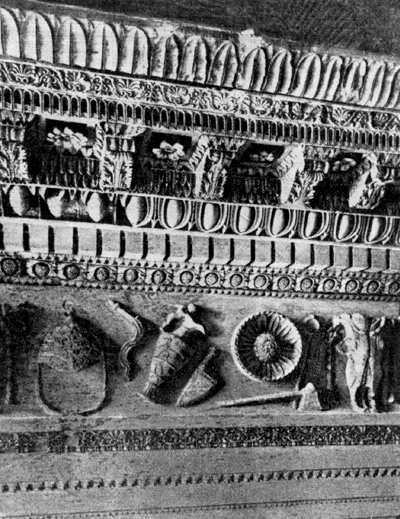 Entablature. Temple of Vespasian, 79 AD.
Entablature. Temple of Vespasian, 79 AD.
List of literature
1. F. Velishsky "Life of the Greeks and Romans"
2. P. Giro "Private and public life of the Romans"
3. Sergeenko M. E. "Life of Ancient Rome"
